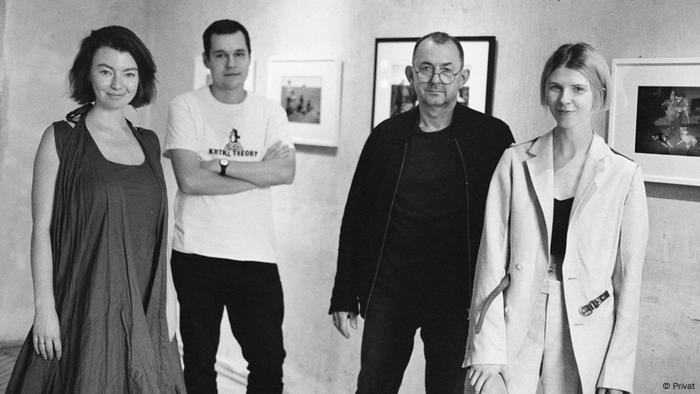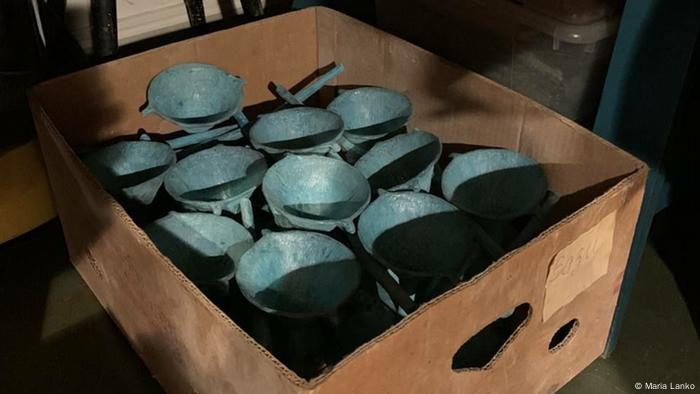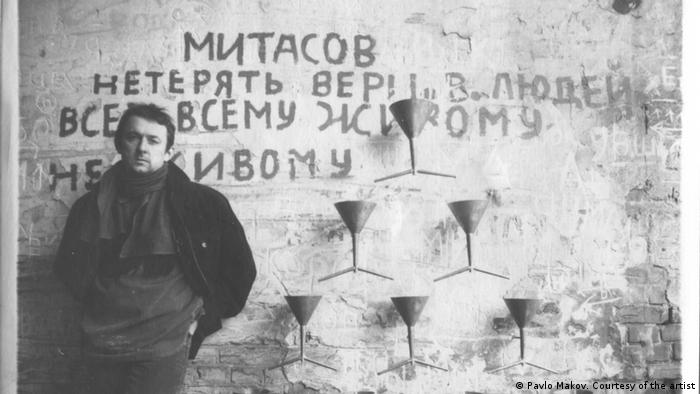As Ukraine's cultural heritage and art faces destruction by Russian shelling and bombs, Ukrainian artists are sending a strong message through the Ukraine pavilion and a special open-air exhibition space.

Art curator Maria Lanko poses by 'Fountain of Exhaustion'
by artist Pavlo Makov at the Ukraine Pavilion in Venice
On the second day of Russia's invasion of Ukraine in late February, curator Maria Lanko and members of her team packed 72 copper funnels into boxes and then loaded them into her small car, which she drove out of Kyiv.
The funnels were components of a sculpture by Kharkiv-based artist Pavlo Makov. Entitled "Fountain of Exhaustion," the work was intended for exhibition at La Biennale di Venezia, commonly referred to as the Venice Biennale, one of the world's premiere international art exhibitions that starts April 23.
Lanko spent over a week driving between cities in western Ukraine before making it to Austria.
"I was the only one in the team who didn't have any children or dependents, and I could just sit in the car and drive away, which I did," Lanko said in a press conference on Wednesday in Venice.
The determination to be present in Venice was "an opportunity to remind the world that Ukraine is an independent nation with its own identity," Ukrainian pavilion curators Lanko, Lizaveta German and Borys Filonenko told DW in March. "And while our people fight for this right on a military front, we take on the cultural one."
On the second day of Russia's invasion of Ukraine in late February, curator Maria Lanko and members of her team packed 72 copper funnels into boxes and then loaded them into her small car, which she drove out of Kyiv.
The funnels were components of a sculpture by Kharkiv-based artist Pavlo Makov. Entitled "Fountain of Exhaustion," the work was intended for exhibition at La Biennale di Venezia, commonly referred to as the Venice Biennale, one of the world's premiere international art exhibitions that starts April 23.
Lanko spent over a week driving between cities in western Ukraine before making it to Austria.
"I was the only one in the team who didn't have any children or dependents, and I could just sit in the car and drive away, which I did," Lanko said in a press conference on Wednesday in Venice.
The determination to be present in Venice was "an opportunity to remind the world that Ukraine is an independent nation with its own identity," Ukrainian pavilion curators Lanko, Lizaveta German and Borys Filonenko told DW in March. "And while our people fight for this right on a military front, we take on the cultural one."

Lizaveta German, Borys Filonenko, artist Pavlo Makov and Maria Lanko (left to right) were determined to take part in Venice
"In times like this, the representation of Ukraine at the exhibition is more important than ever," the curators said in a statement confirming their dedication to bring the work to Venice, despite the sculpture platform and other parts having been left in Ukraine. These were later reconstructed in Italy.
"When the sheer right to existence for our culture is being challenged by Russia, it is crucial to demonstrate our achievements to the world," they added.
Symbol of 'freedom and independence'
Now the "Fountain of Exhaustion" is standing at Ukraine's pavilion in Venice. The work symbolizes exhaustion; the 72 copper funnels are arranged in the form of a pyramid through which water struggles to travel.
The 63-year-old Makov first conceived of this "metaphor of exhaustion" in the mid-1990s. It was a statement of the struggle afflicting post-Soviet societies, but it is still being played out in the context of the war in Ukraine, Makov said.
"Behind any war, there is a cultural conflict," Markov said at Wednesday's press conference, adding that Ukraine and Russia's cultural conflict is not recent but has been ongoing "for hundreds of years."

The funnels that make up Pavlo Makov's artwork were evacuated from Kyiv by car
He referred to artists and writers who had been integral to a "Ukrainian renaissance" and were "eliminat[ed]" by the Soviet revolutionary Bolsheviks in the 1920s. He said that this is happening again and explained his view of the two sides of the long-unfolding conflict.
"One of them is built on a great respect to power and dominance; the other is built on a respect to freedom and independence," said Makov.

Ukrainian artist Pavlo Makov exhibited 'Fountain of Exhaustion' in Kharkiv in 1996
This conflict is playing out now in Ukraine, Ukraine pavilion curator Borys Filonenko said on Wednesday. He asked the art world to "shift your focus to Ukrainian culture" that is being targeted by Russian attacks — the curators said over 230 attacks on cultural sites and objects have been recorded by the Ukrainian Culture Ministry, including the intentional destruction of the Mariupol Theater. The UN's cultural institution, UNESCO, has tallied over 100 damaged or destroyed cultural sites since the start of the war.
"Today history meets Ukraine. History meets 'Fountain of Exhaustion'. And history meets La Biennale," Filonenko said.
Piazza Ucraina: Place of solidarity with Ukraine
Over the past week, the Ukrainian pavilion's curators have created a new open-air exhibition space, Piazza Ucraina, in the heart of the Biennale's exhibition area.
At the center of the open space is a monument covered with sandbags, a wartime practice in Ukrainian cities to try and shield public art from shelling. The rest of the space features charred wooden polls that serve as display stands for artwork created by Ukrainian artists in the midst of war.
Many of these works have already been released to the public via social media. "They become an evidence, an artifact, a document of the state of mind," the curators said in a statement.
"Perhaps, these works have already gained a status of the most sincere and certainly undeniable documentation of the experience: the one of trauma, of anger and, yet, of sheer courage, too," they added.
"Is it possible to make art after Bucha?" Filonenko asked, referring to the massacrein the suburb of Kyiv. Yet he added that artists, some of whom are working in the Ukrainian army, continue to express themselves.
The artworks at Piazza Ucraina were collected as part of the Wartime Art Archive compiled by the Ukrainian Emergency Art Fund, which was established to "deal with the consequences of the Russian invasion and threats the war poses on the Ukrainian art community."
The fund organizes emergency grants and administers donations and overseas residencies so Ukrainian artists can continue their work.
No comments:
Post a Comment